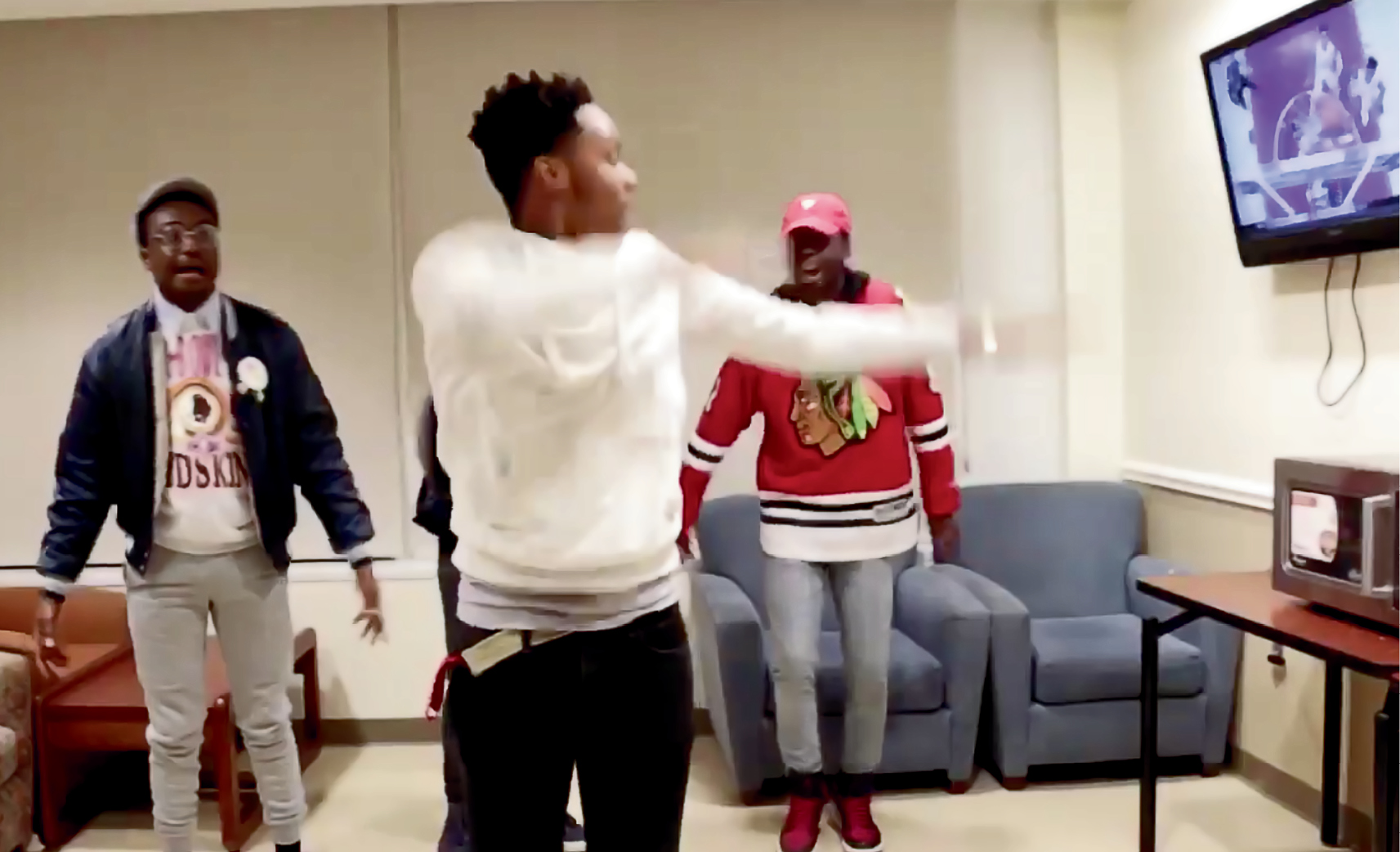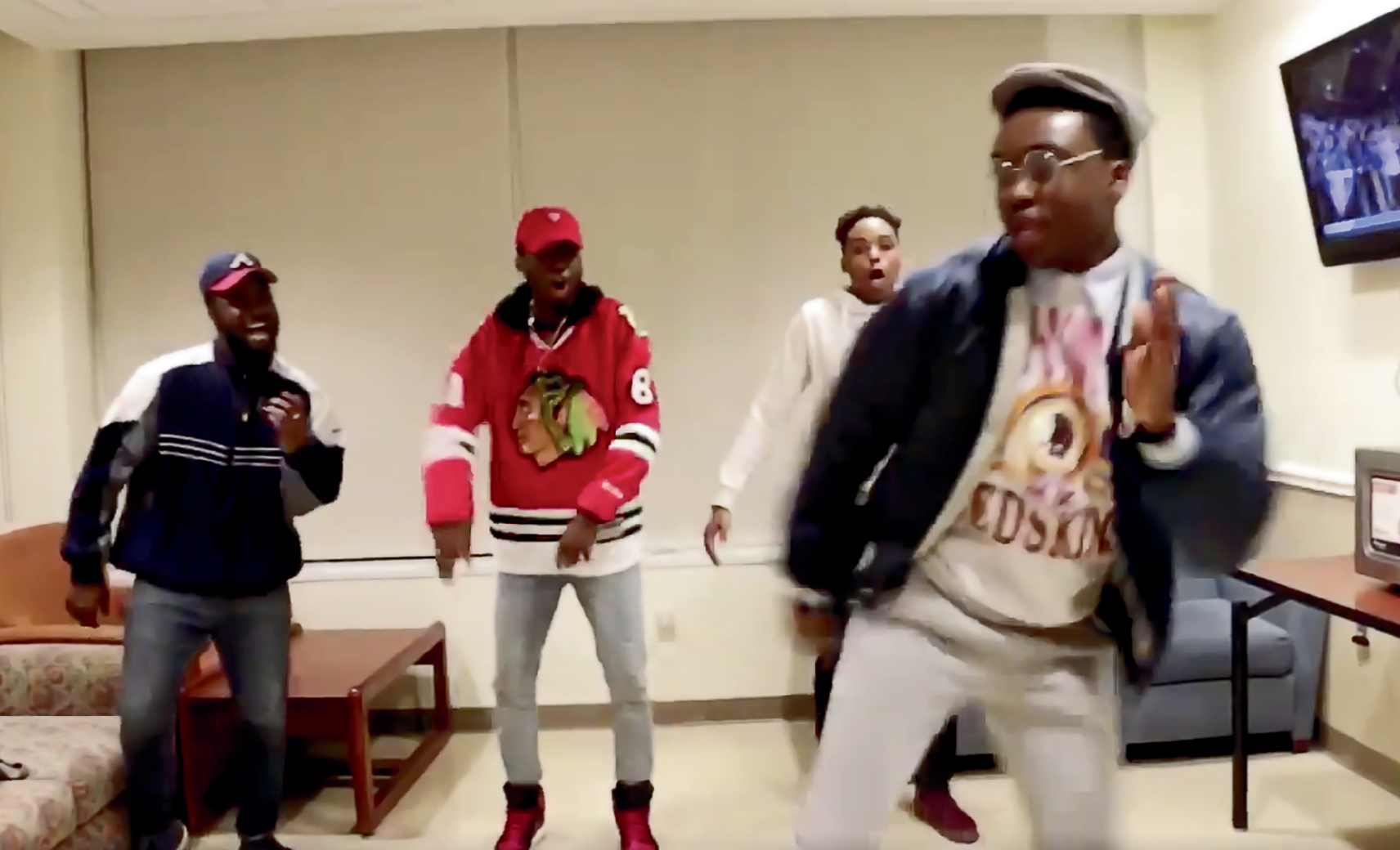
THE #OPTIMISTICCHALLENGE: DECISIVE BLACK JOY
JASMINE JOHNSON
Chance the Rapper posted a video to his Instagram account on January 19, 2017, the day preceding the bleak inauguration of the 45th president of the United States. In it, Chance and three other Black men dance on a back porch to the sanguine Sounds of Blackness gospel hit “Optimistic” (1991). On the heels of the #MannequinChallenge, a viral meme in which groups staged scenes of spectacular stillness, what would become known as the #OptimisticChallenge offered a different embodied register: On the cusp of an impending political future humming with calamity, here were vignettes of Black folks deciding on jubilee.
Internet bellwether Jay Versace inaugurated the meme. “2017 got me feeling like,” he captioned a video of himself and three other Black men delighting in 1990s-era choreography. Clad in outfits hailing from the first seasons of The Fresh Prince of Bel-Air, the young men execute moves from a distinctly 1980s and ‘90s Black dance repertoire: the wop, the running man, the Kid ‘n Play, and the more recent Harlem shake. The moments of shared choreography make each individual’s embodied flair visible. In Versace’s video, the group dances in the middle of the street beneath a marbled gray sky: Black joy below the threat of a thunderstorm.
If the canonical final act of Sister Act 2: Back in the Habit (1993) refashioned into a meme, it would look like the #OptimisticChallenge. The two aforementioned videos feature Black men dancing, appropriately evoking the hashtag #blackboijoy. Indeed, contributing to the meme’s efficacy is its indifference to dictated gender roles and policed Black sexualities. “Come now and as you are,” the meme seems to thrum. Beyond these two widely circulated videos, though, the broader range of #OptimisticChallenge submissions include men, women, and children whose dancing animates a range of Black spaces. The hashtag digitally coheres disparate social and geographical coordinates of Black life: playgrounds, living rooms, barbershops, and classrooms from around the world. The sum of these videos is a refusal to wait for buoyancy to miraculously arrive. Collectively, the choreographies are “action engaged to enlarge capacity, confirm presence, to dare.”1 As such, the Challenge is an election of Black carefreedom. “Keep, keep on,” the lyrics appeal, “Never say die.”
Reminiscent of a genre of music videos from Black girl and boy groups like Soul for Real, Bell Biv DeVoe, and Xscape, the meme indexes a history of popular Black social dances that have emerged over the past thirty years. Black performance studies scholars Thomas DeFrantz and Anita Gonzalez write this: “Black performance contains history and racism, but it is not about either of those things.”2 The #OptimisticChallenge is of a history of antiBlack violence, but it is not necessarily about that terror. Rather, its protagonist is a history of Black positivity made manifest through embodied innovation. Like Black social dance itself, the Challenge confronts contextually specific limitations on Black civic, social, and psychic life while imagining freer, more ecstatic, and unconstrained Black futures.
The Black body is a technology: It knows, remembers, and utters. The Black body in choreographic motion—when amplified by viral circulation—only heightens this intelligence. Black social dance is an instrument of the people: It transmits, convenes, and envisions. It is contagious and emerges from “the circle,” or Black social gathering, through which embodied innovation materializes.3 Through the hashtag, that circle opens up to those who are not physically present, but who are able to feel through the camera’s witness. The #OptimisticChallenge coils this social dance circle into a digital spirograph of Black elation.
“When you pray, move your feet,” the West African proverb goes. In this light, we might understand the #OptimisticChallenge as fierce future thinking rather than passivity. It is a “challenge” after all—not a concession. As such, the meme reminds us that ongoing endangerment is precisely why we must “never say die.” Better instead to caper, bob, whirl inside the alchemy of Black joy given shape through dance.





All images courtesy of Troubled Empire
1. DeFrantz, Thomas F., and Anita Gonzalez, “Introduction: From ‘Negro Expression’ to ‘Black Performance.’ ” In Black Performance Theory, edited by Thomas F. DeFrantz and Anita Gonzalez (Durham and London: Duke University Press, 2014), 5.
2. Ibid., 9.
3. Hazzard-Gordon, Katrina, Jookin’: The Rise of Social Dance Formations in African-American Culture (Philadelphia: Temple University Press, 1990); Jacqui Malone, Steppin’ on the Blues: The Visible Rhythms of African American Dance (Folklore & Society) (Chicago: University of Illinois Press, 1996); DeFrantz, Thomas F., “Foreword: Black Bodies Dancing Black Culture—Black Atlantic Transformations” in EmBODYing Liberation: The Black Body in American Dance, edited by Dorothea Fischer-Hornung and Alison D. Goeller (New Brunswick and London: Transaction Publishers, 2001).
JOHNSON